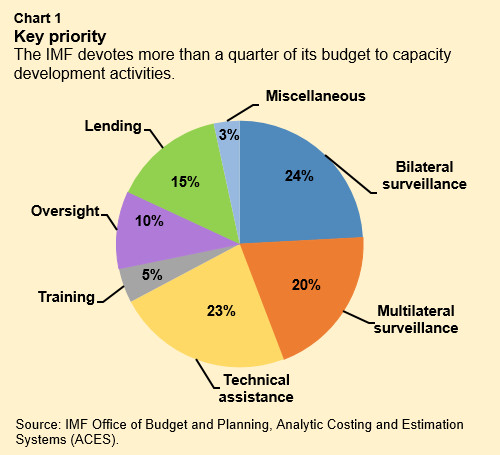
Myanmar
The IMF's 2016 Annual Report highlights capacity development activities in Myanmar and other places (photo: Nathalie Cuvelier/robertharding/Newscom)
IMF Responds to Worldwide Demand for Capacity Development
September 26, 2016
- IMF spending on capacity development up for sixth straight year, to $256 million
- Largest share of IMF technical assistance and training went to Africa
- IMF approved $9.2 billion in new loans to 16 countries, including 13 developing countries
Demand for the International Monetary Fund’s advice from its membership across the globe remains high, especially on fiscal topics designed to help mobilize domestic resources for development, according to the IMF Annual Report 2016—Finding Solutions Together.
IMF technical assistance and training—which it calls capacity development—accounts for more than one quarter of the IMF’s activities (Chart 1). Nearly half of all IMF technical assistance goes to low-income developing countries, and most of the remaining amount to emerging market economies, with some advanced economies receiving technical assistance as well. Of all regions, sub-Saharan Africa received the largest share of this assistance (Chart 2). At the same time, the IMF delivered 375 training events for nearly 15,000 officials around the world, while online training participation grew sharply by 218 percent last year.
A regional approach
The IMF’s global network of regional technical assistance centers in the Pacific, the Caribbean, Africa, the Middle East, and Central America helps countries strengthen their human and institutional capacity to design and implement policies that promote growth and reduce poverty. This regional approach enables the Fund to better tailor its assistance to the particular needs of a region, more closely coordinate its support with other assistance providers, and respond more quickly to emerging needs, as well as foster regional integration.
In FY2016, the IMF signed an agreement with the Indian government for a new South Asian Regional Training and Technical Assistance Center, to be based in New Delhi. The new center, which was made possible by early financial commitments from India, the Republic of Korea, and Australia, will serve Bangladesh, Bhutan, India, Maldives, Nepal, and Sri Lanka.
IMF centers focus on financial sector supervision, tax and customs administration, medium-term expenditure frameworks and public financial management, money markets and monetary policy frameworks, and macroeconomic statistics—topics key to helping countries advance toward the UN Sustainable Development Goals. Chief among the topics in demand is fiscal issues (Chart 3).
A portal to the IMF
The IMF Annual Report 2016—Finding Solutions Together combines feature articles, thematic organization, and infographics, with online innovation. The “Spotlights” section explores key activities of the IMF Executive Board, management, and staff during the financial year that ran from May 1, 2015 through April 30, 2016. These include the quota reform, addition of the Chinese currency to the basket of currencies used to determine the IMF’s Special Drawing Right (SDR), and IMF’s contribution to Financing for Development.
“Learn” tabs throughout the report explain in lay terms the sometimes complex material, such as how IMF quotas work and how the SDR basket will change on October 1. The “Regional Highlights” section starts with a special report on the economic impact of the surge in refugees and its impact on both the refugees’ home countries in the Middle East and the host countries in Europe.
Charts and other graphics illustrate the IMF’s three core activities during the year. In addition to its capacity development work, the Fund conducted 117 reviews of the economic and financial policies of individual member countries, as well as analysis of global and regional economic trends and spillovers from members’ policies onto the global economy. It also approved $9.2 billion in new loans to 16 countries, including $1.2 billion in low- or zero-interest loans to 13 low-income developing countries.
The report is available in print in eight languages (Arabic, Chinese, English, French, German, Japanese, Russian, and Spanish), and on CD-ROM (in English only). The Annual Report web page, now in fully responsive html format, includes the IMF’s financial statements for FY2016 and other background documentation, and is also available in Chinese, French, and Spanish. Copies of the Annual Report, the financial statements, and the CD-ROM are available free of charge from IMF Publication Services, P.O. Box 92780, Washington, DC 20090, online at www.imfbookstore.org or www.elibrary.imf.org, or by e-mail at publications@imf.org.
IMF capacity development delivers results
The IMF provides technical assistance on several topics in its areas of expertise. Most in demand by the membership are fiscal issues such as tax reform, followed by the monetary and financial sector, statistics, and legal issues. IMF capacity development activities are integrated with the ongoing policy dialogue between members and the Fund.Myanmar: After 50 years of relative isolation, the country launched a tax reform strategy designed with IMF support, and its revenues from major taxes have increased on average more than 20 percent annually since 2012.
Mali: IMF technical assistance is helping to ensure a gradual transfer of 30 percent of government revenue to the country’s regions by 2018.
Ukraine: As the economy and financial sector emerge from their deepest crisis since independence, IMF assistance is helping to enhance bank supervision, the foreign exchange market, domestic debt issuance, monetary policy, and the structure of the central bank.
Paraguay: IMF assistance centered on implementing risk-based banking supervision and implementing inflation targeting.
Central Asia: Azerbaijan, the Kyrgyz Republic, and Tajikistan have improved their external sector statistics with IMF support. Member countries need high-quality macroeconomic statistics as the foundation for their economic decision-making.
Myanmar and Ukraine received IMF technical assistance in anti-money laundering and combating the financing of terrorism.










